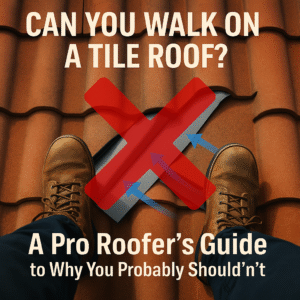Can You Walk on a Tile Roof? A Pro Roofer’s Guide to Why You Probably Shouldn’t
The Short Answer: Should You Walk on a Tile Roof?
No, homeowners should not walk on a tile roof. Clay and concrete tiles are extremely fragile under direct foot pressure. Walking on them incorrectly will almost certainly crack tiles, breaking the roof’s primary water barrier and leading to hidden, expensive leaks. Only certified professionals with specific training and specialized gear should ever walk on a tile roof, and even they do so as little as possible.
I’ll never forget the call I got about a historic Spanish-style home in Santa Barbara. A new painting crew, inexperienced with tile, had spent a day walking all over the 80-year-old clay roof to prep the walls. The homeowner called me a week later after the first rain. I found over 50 cracked and shattered tiles. A simple paint job had turned into a $12,000 repair job, requiring custom-matched tiles and extensive labor. This is the reality of foot traffic on a tile roof—it’s a system that’s incredibly durable against weather but exceptionally fragile against misplaced weight.
So, while the technical answer is that it’s *possible* to walk on a tile roof, the practical and safe answer for any homeowner is a resounding “no.” In this guide, we’ll explore exactly why tile is so fragile, the right way professionals do it (for your education, not imitation), and the much safer alternatives you should use for any task that requires getting near your roof.
The Anatomy of a Broken Tile: Why It’s More Than Just a Crack
Many homeowners think, “It’s just one cracked tile, what’s the big deal?” This misunderstanding can lead to catastrophic damage. A tile roof is not a single waterproof membrane; it’s an interlocking system of individual components designed to shed water.
The Chain Reaction of a Single Crack
- The Water Barrier is Breached: The tiles are the primary line of defense. When one cracks, water now flows directly onto the underlayment below.
- Underlayment Exposure: The underlayment (usually a felt or synthetic membrane) is now exposed to direct sunlight and UV rays through the crack. This rapidly degrades the material, making it brittle and shortening its lifespan from decades to just a few years.
- A Hidden Leak Begins: Once the underlayment fails, water reaches your roof decking, causing slow, hidden rot. By the time you see a stain on your ceiling, the damage to the underlying structure is often extensive and expensive to repair.
A single broken tile, if ignored, can easily cause thousands of dollars in structural damage. The initial `roof-inspection-cost/` to have a professional identify such issues is minuscule in comparison.
Know Your Tile: Different Profiles, Different Points of Failure
Not all tiles are created equal. Understanding the type of tile on your roof is key to understanding its specific fragility. The walking technique varies significantly between them, which is why it’s a skill for professionals only.
High-Profile “S” or Barrel Tiles
These are the classic, wavy tiles common on Spanish and Mediterranean-style homes. They are typically made of clay and are extremely brittle at their weakest points.
Pro Technique: Weight should only be placed on the balls of the feet at the peak of the convex curve on the “headlap”—the top 3-4 inches of the tile in the course below, where the tiles overlap and provide double thickness.
Avoid: The valley, or concave part of the tile. Stepping here will snap it instantly.
Low-Profile & Flat Tiles
Commonly made of concrete, these tiles offer a sleek, modern look. While concrete is stronger than clay, these tiles are thin and will crack easily if flexed.
Pro Technique: Foot placement must be on the lower third of the tile, which is the only part fully supported by the tile below it and the wooden batten underneath.
Avoid: The center or top of the tile, where it is unsupported and will break under pressure.
The fragility of tile is a sharp contrast to other durable systems. For example, knowing `can-you-walk-on-a-metal-roof/` involves understanding where the structural supports are, but the panel itself is far more resilient to impact than a piece of fired clay.
The Professional’s Technique (Educational Purposes Only)
To truly underscore why this is a job for pros, it’s helpful to understand the level of skill and care involved. I teach my crews these rules, and they practice them for months before they are proficient.
- Distribute Weight: Professionals use specialized foam ladders or padding to distribute their weight over a larger area, avoiding point pressure.
- Foot Placement is Everything: They walk softly on the balls of their feet, landing only on the specific, reinforced parts of the tiles as described above.
- Face the Peak: When moving up or down the roof, they always face the ridge, maintaining three points of contact.
- Never Pivot or Scuff: Turning or twisting your feet will grind the granular surface and can break the delicate interlocking edges of the tiles.
This level of precision is not something that can be learned from an online guide; it comes from years of experience.
Safe Alternatives to Walking on Your Tile Roof
So, if you can’t walk on your roof, what do you do when you need to inspect it, clean gutters, or retrieve a drone? You use safer methods that don’t involve setting foot on the tile.
- Inspect from the Ground: Your best tool is a quality pair of binoculars. You can spot 90% of potential problems, like cracked tiles or debris buildup, from the safety of your yard.
- Use a Ladder at the Eave: You can safely clean the first few feet of your gutters from a properly positioned extension ladder. – **Hire a Professional for a Full Inspection:** For a comprehensive check-up, especially after a storm, hiring a pro is the way to go. They have the training and equipment to do it safely. – **Drone Inspections:** The modern, safe alternative. A drone can provide high-resolution photos and videos of every inch of your roof without anyone taking a single step.
The Pro’s Toolkit: Essential Gear for Working on Tile
When my team works on a tile roof, they are equipped with specialized gear. This isn’t a DIY shopping list; it’s a look into what it takes to do this job safely and correctly.
1. Specialty Footwear: Cougar Paws Estimator Boots
You will never see a true tile professional wearing hard-soled work boots. They use soft, high-traction footwear. Cougar Paws boots, with their foam-like soles, are an industry standard. They provide incredible grip while being gentle on the roofing material. The soft sole helps prevent cracking by distributing pressure more evenly than a rigid boot.
Check Price on Amazon2. Full Fall Arrest System: Guardian “Bucket of Safe-Tie”
This is non-negotiable. Tile roofs are steep and slippery. Every member of my crew is tied off 100% of the time. This professional kit includes everything needed: a high-quality harness, a reusable roof anchor, and a 50-foot lifeline. There are no excuses for working on a tile roof without a proper fall arrest system.
Check Price on AmazonFrequently Asked Questions About Tile Roofs
Will my homeowners insurance cover tiles I break by walking on the roof?
Almost certainly not. Standard homeowners insurance policies exclude damage caused by the homeowner’s own actions or lack of maintenance. If you crack tiles by walking on them, the resulting leaks and repairs will be an out-of-pocket expense. This is a key reason why it’s crucial to understand your policy and why homeowners often have questions about what happens if they don’t use their insurance money for professional repairs.
How can I tell if my tiles are clay or concrete?
From the ground, it can be tough. Generally, clay tiles have a more classic, reddish “terracotta” color and often have a slight sheen. Concrete tiles tend to have more uniform, muted colors (greys, browns, tans) and a flatter, more matte finish. Concrete is also heavier and typically a bit thicker.
Is it okay to pressure wash a tile roof?
Absolutely not. High-pressure water can easily get forced up and under the tiles, saturating the underlayment and decking. It can also strip the finish off concrete tiles. The professional method is called “soft washing,” which uses low pressure and specialized, eco-friendly cleaning solutions to kill moss and algae without damaging the roof system.
What if I need to address a pest problem?
Tile roofs can have gaps that attract pests. If you suspect an issue because you’re worried that roof rats are dangerous or you need to install deterrents like the best bird spikes, this is a job for a professional who is licensed, insured, and experienced with both pest control and tile roofing.
Final Verdict: Respect the Tile, Hire a Professional
So, can you walk on a tile roof? For any homeowner, the answer should be a clear and definitive **no**. The risk of causing thousands of dollars in hidden damage or suffering a serious fall is far too high. A tile roof is a beautiful, durable, and complex system that requires a specialist’s touch.
Your roof is not a deck or a patio. It’s a finely crafted shield for your home. Treat it with the respect it deserves. For inspections, maintenance, or repairs involving components like roof flashing, always call a qualified and insured professional with specific experience in tile roofing. It’s the smartest investment you can make in the long-term health and integrity of your home.




